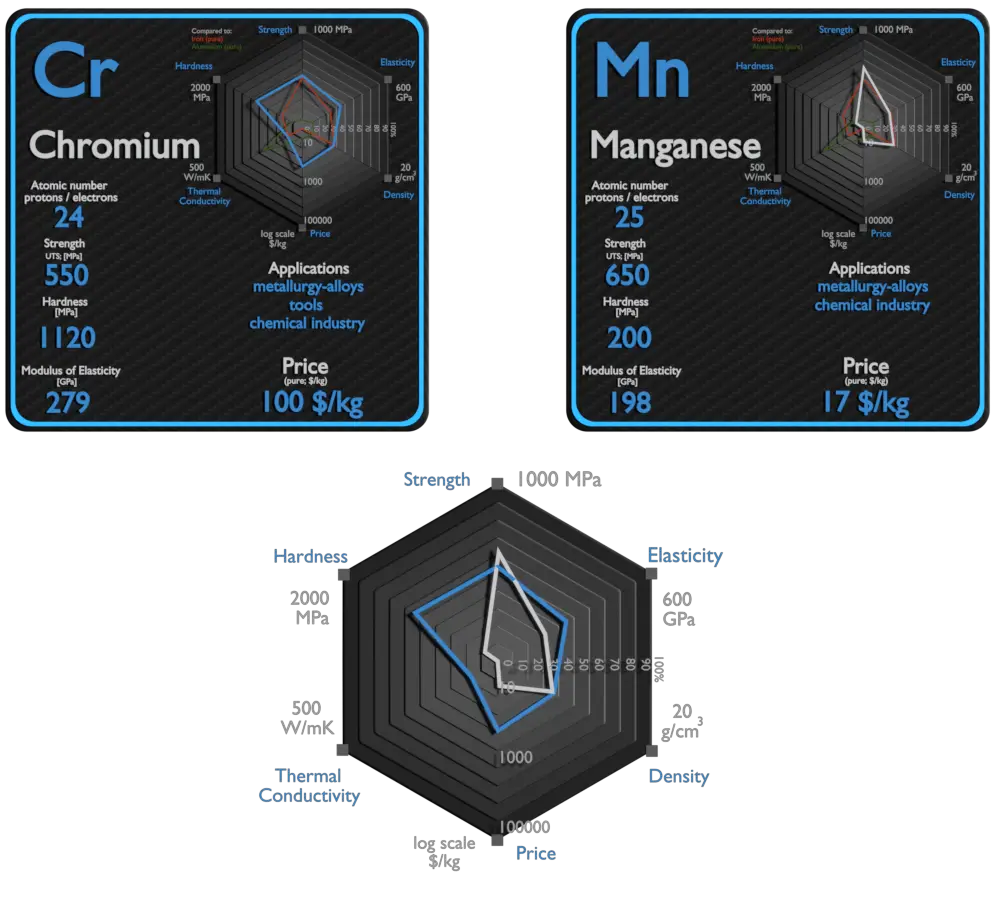This article contains comparison of key thermal and atomic properties of chromium and manganese, two comparable chemical elements from the periodic table. It also contains basic descriptions and applications of both elements. Chromium vs Manganese.

Chromium and Manganese – About Elements


Source: www.luciteria.com
Chromium and Manganese – Applications
Chromium
Chromium is one of the most important and indispensable industrial metals because of its hardness and resistance to corrosion. But it is used for more than the production of stainless steel and nonferrous alloys; it is also used to create pigments and chemicals used to process leather. In metallurgy, Chromium increases hardness, strength, and corrosion resistance. The strengthening effect of forming stable metal carbides at the grain boundaries and the strong increase in corrosion resistance made chromium an important alloying material for steel. Generally speaking, the concentration specified for most grades is approximately 4%. This level appears to result in the best balance between hardness and toughness. Chromium plays an important role in the hardening mechanism and is considered irreplaceable. At higher temperatures, chromium contributes increased strength. It is ordinarily used for applications of this nature in conjunction with molybdenum. The resistance of stainless steels is based on passivation. For passivation to occur and remain stable, the Fe-Cr alloy must have a minimum chromium content of about 11% by weight, above which passivity can occur and below which it is impossible.
Manganese
Manganese is an important alloying agent. Almost 90% of the manganese produced annually is used in the production of steel. In steels, manganese improves the rolling and forging qualities, as well as strength, toughness, stiffness, wear resistance, hardness and hardenability. The second largest application for manganese is in aluminium alloys. Aluminium with roughly 1.5% manganese has increased resistance to corrosion through grains that absorb impurities which would lead to galvanic corrosion. Manganese can be formed into many useful compounds. For example, manganese oxide, which can be used in fertilizers and ceramics.
Chromium and Manganese – Comparison in Table
| Element | Chromium | Manganese |
| Density | 7.14 g/cm3 | 7.47 g/cm3 |
| Ultimate Tensile Strength | 550 MPa | 650 MPa |
| Yield Strength | 131 MPa | 230 MPa |
| Young’s Modulus of Elasticity | 279 GPa | 198 GPa |
| Mohs Scale | 8.5 | 6 |
| Brinell Hardness | 1120 MPa | 200 MPa |
| Vickers Hardness | 1060 MPa | N/A |
| Melting Point | 1907 °C | 1246 °C |
| Boiling Point | 2671 °C | 2061 °C |
| Thermal Conductivity | 93.7 W/mK | 7.82 W/mK |
| Thermal Expansion Coefficient | 4.9 µm/mK | 21.7 µm/mK |
| Specific Heat | 0.45 J/g K | 0.48 J/g K |
| Heat of Fusion | 16.9 kJ/mol | 12.05 kJ/mol |
| Heat of Vaporization | 344.3 kJ/mol | 266 kJ/mol |





